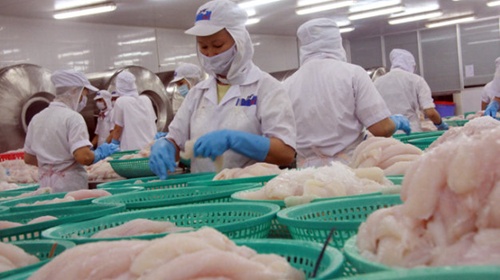Trade ministry monitors impact of weaker yuan on exports
Trade ministry monitors impact of weaker yuan on exports
The Ministry of Industry and Trade is keeping a close watch on the impact of China’s sharp yuan devaluation on the exchange rate between the U.S. dollar and the local dong currency and on Vietnam’s foreign trade.
“We are closely following the situation and evaluating its impact to take proper measures,” a leader of the ministry’s Asia-Pacific Market Department told the Daily on August 12 after China’s yuan had dipped for a second day on August 12, hitting a four-year low. China devalued its currency by a total of nearly 4% on Tuesday and Wednesday.
Experts said the yuan depreciation would hit two-way trade between Vietnam and China as Vietnam has had a big trade deficit with China over the years and local firms have relied heavily on imports from the northern neighbor.
Vietnam exported US$13.2 billion worth of products to China and imported goods worth US$36.9 billion from the neighboring nation in 2013. The respective figures were US$19.9 billion and US$43.7 billion last year, hence the trade deficit of US$23.8 billion.
According to the ministry’s industrial and commercial information center, Vietnam ran a trade deficit of US$16.5 billion with China in the first half of this year and imports from that country in the period soared nearly 24% year-on-year.
Steel, machines and equipment, phones and phone accessories, computers, and textile materials are among the major items Vietnam imports from China with annual spending on each product amounting to more than US$1 billion.
Experts predicted that local apparel and steel producers would order more materials from China for short-term deliveries to enjoy lower prices due to the yuan devaluation.
The reason is that the yuan weakened by nearly 4% against the U.S. dollar while the State Bank of Vietnam on August 12 decided to widen the dong/dollar trading band from 1% to 2% on either side, effectively devaluing the local currency by 1% against the dollar.
China has stepped up steel exports as shown by figures of the Chinese customs. Accordingly, China’s exports in July fell 8.3% compared to the year-earlier period but steel shipments went up 9% year-on-year and 21% month-on-month. This meant China had increased steel exports to ease an oversupply on the domestic market.
Truong Van Phuoc, vice chairman of the National Financial Supervisory Commission of Vietnam, warned of more Chinese goods flooding the local market and urged relevant authorities to find ways to deal with this possibility.
Phuoc estimated this year’s trade deficit at US$5-7 billion, saying this would not be a big problem as incoming remittances were projected at US$12-14 billion.
Phuoc said more time would be needed to see what China would do with its currency in the coming time.
Concerns of local firms
Local seafood and farm produce firms whose major export markets include China have felt the pinch of the yuan’s weakening.
Truong Dinh Hoe, general secretary of the Vietnam Association of Seafood Exporters and Producers (VASEP), told the Daily that the yuan fall would impact have on Vietnamese exports to the Chinese market.
Prices of Vietnamese seafood exported to China would be higher if local exporters wanted to settle payments in the U.S. dollar, Hoe said.
“China’s yuan devaluation is aimed to improve the competitiveness of its export products including those similar to Vietnam’s products like tilapia fish and shrimp,” Hoe said.
Figures of VASEP showed shirmp exports in the year to mid-July had dropped over 28% year-on-year to US$1.4 billion due to sharp declines of revenues from major export markets like the United States (down 50%), China (28%), Japan (19%), Korea (17%) and the European Union (14%).
VASEP forecast outbound sales of shrimp this year could tumble by US$700 million from US$3.9 billion last year.
However, he said it was too premature to assess the impact of the weaker yuan on Vietnamese exports to the northern market.
Rice sold to China has accounted for 30-40% of Vietnam’s total rice exports in recent years, according to Lam Anh Tuan, director of Thinh Phat Co. Ltd. in the Mekong Delta province of Ben Tre. But he said the export price of this staple food has remained unchanged.
By June 20, member enterprises of the Vietnam Food Association (VFA) had signed contracts to ship 1.65 million tons of rice with the volume pending for deliveries estimated at 860,000 tons.
Though Dang Phuong Dung, vice chairwoman of the Vietnam Textile and Garment Association, said local apparel firms would have a chance to import materials at lower prices due to the yuan depreciation but said that it would not be good in the long term as 42% of the sector’s current material imports came from China.
Dung hailed the State Bank of Vietnam’s move to increase the trading band to 2% on either side as it would help local exporters maintain their competitiveness in the face of the yuan slide.




















